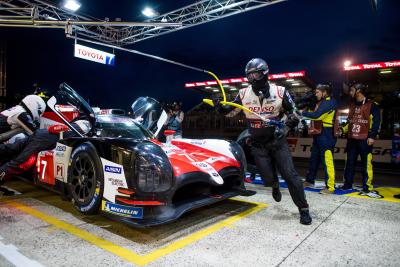Can Toyota really lose the 24 Hours of Le Mans?
Maybe just by writing this headline, fate has been tempted. Maybe we’re set for the same heartache that has burdened Toyota in recent years.
Or maybe, this time around, Toyota will finally take its elusive maiden victory at the 24 Hours of Le Mans.
Ever since Porsche confirmed its departure from LMP1, the top class of sports car racing, question after question has been asked of Toyota. Would it continue to race? Would it be worth fighting alone for top manufacturer honours in LMP1? More worryingly: can it really lose at Le Mans?
Maybe just by writing this headline, fate has been tempted. Maybe we’re set for the same heartache that has burdened Toyota in recent years.
Or maybe, this time around, Toyota will finally take its elusive maiden victory at the 24 Hours of Le Mans.
Ever since Porsche confirmed its departure from LMP1, the top class of sports car racing, question after question has been asked of Toyota. Would it continue to race? Would it be worth fighting alone for top manufacturer honours in LMP1? More worryingly: can it really lose at Le Mans?
On paper, the odds are stacked heavily in the favour of Toyota, which will be fielding two cars in tomorrow’s race. The Toyota TS050 Hybrid has raced in the FIA World Endurance Championship since the start of 2016, winning seven races in that period. Its reliability is well-proven, as is its speed, holding the record for the two fastest laps in Le Mans history (the 2017 pole lap, followed by this year’s pole lap).
Efforts have been made to try and peg back the Toyotas to try and create some competition at the very front of the field following the arrival of a number of new LMP1 privateer teams this year in the wake of Porsche’s departure. These teams run non-hybrid technology, giving them simpler cars to run, albeit lacking some of the advantages the hybrid Toyotas have. To try and level the playing field, Toyota has been subject to some restrictions. It will have 69 percent less fuel energy than the privateers, 30 kg/h less fuel flow and will have to run 45 kg heavier in the race.
However, Toyota isn’t totally hamstrung. Tweaks made to the rules have limited the amount of fuel the privateers can run, giving them one lap less per stint than the Toyotas around Le Mans. And its pace advantage is still clear. In qualifying, the gap was 2.8 seconds between Kazuki Nakajima’s pole lap and the fastest privateer time (which was then deleted due to a scrutineering infraction, widening the gap to four seconds). While the team believes this gap will be smaller in the race, it is still significant enough. At Spa last month in the six-hour WEC season-opener, Toyota finished two laps clear. Will that gap be even bigger this time around?
On paper, Toyota cannot lose this race. But as it has found out to its cost in recent years, Le Mans of all races is never, ever won on paper.
Reliability has been the big sticking point for Toyota through the years. Its heartbreaking defeat on the final lap of the race in 2016 is the most extraordinary example, yet the meltdown through the night at last year’s race is evidence of there being no certainties at this race. Even with three bullets in the gun, a mix of bad luck and freak incidents ruled all three out of victory contention, handing the win on a plate to Porsche despite its own issues. A pace advantage is simply mathematical.
“It’s completely underestimated, because everyone thinks it’s only Toyota’s race to lose,” explains Sebastien Buemi, who was part of the crew that so cruelly lost the race with minutes to go in 2016.
“On paper, it is. But to be honest, to win that race, even when Audi was coming here for five or six years without anyone, it’s not so easy. We have two cars. Anything can happen.
“In qualifying you saw how many people went off, everywhere, every five minutes there is a slow zone. One guy goes off and hits you, what can you do? The race could be over, and that’s it.”
Toyota has left not a single stone unturned in its preparation for this year’s race. Without having to chase as much performance in order to make up for any gains a rival team - previously Porsche - could make, it could focus obsessively about the reliability of its car. Measures have been put in place to prevent the exact issue that denied it victory in 2016, while even crazy simulations such as driving the car on three wheels, shutting off all of the electronics or driving with a cone under the wheel guard.
If all else fails, the team must be able to get the car back to the garage so it can repair any issue that may have cropped up, as if the car gets stranded out on the circuit, it's out of the race.
“It is a very different preparation, and it feels good,” Jose Maria Lopez says. “There are many things that people don’t know that they see in the race. Our car is a very complex car with a hybrid system and a lot of things that need to work together.
“In case of a problem, with the probabilities being higher as you have more components, it is done in a way to minimise and be reactive quicker to any problem and try to always get the car home. We have run a lot and we are much more prepared on that case so let’s hope nothing happens. In case it happens, we have prepared for it.”
“Sometimes you think it’s a problem with the simulator at one point, you’re thinking ‘why am I crabbing down the road at a slow speed?’” adds Lopez’s co-driver, Mike Conway.
“They just simulate punctures or whatever it may be. It’s good to get you prepared. You get a puncture at this place, it’s a long way to get back. You can destroy the car if you’re going too quick. It’s things like that, simulating all the kinds of scenarios that can happen. Hopefully it’s all enough and will get us back in a good result.”
The spotlight on Toyota has only grown more intense given the presence of two-time Formula 1 world champion Fernando Alonso in the car this year as he makes his Le Mans debut, continuing his pursuit for the ‘triple crown of motorsport’. But even the Spaniard says the focus is on the team finally breaking its long Le Mans drought, not on any single person within the team.
“I think we all drivers, engineers, mechanics, everyone wants to break that statistic for Toyota and Le Mans,” Alonso stresses.
“We definitely have to be on the top step of the podium, one of the two Toyotas. At the same time, it will be nice to be on our car, but to be honest it’s one of those races that all six drivers, we will be extremely happy if car 8 or car 7 wins. All the mechanics will be happy, the management, everyone, is totally fair and totally happy.
“I think this year especially, it’s more about Toyota and Le Mans than any other individual. We will try to do our best, and help each other in the best way we can.”
There is a mantra that you don’t just have to beat your competitors at Le Mans, but you have to beat Le Mans itself. And for Toyota, that will be the challenge tomorrow. Should it finally complete its long-held goal of winning Le Mans at the 19th attempt, the enormity of the achievement must not be understated.











